 |
Number of versions: 4
Edition: July 22, 2007
|

From the early twentieth century on the so called Folk Games were home made in
America. These monopoly-like Folks Games were designed and played by
Quakers in the Philadelphia and Atlantic City area, in the east part of America.
They were called "The Landlord's Game", the name Lizzie Magie
already gave to the game she described in her 1904's patent.
Till today over the whole world and for various reasons countless
self-made games have been made.
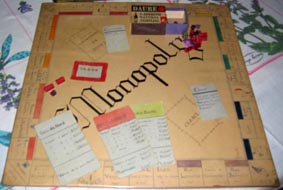 Edition: War scrap Monopoly Edition: War scrap Monopoly
Makers: Renée (12) and Jean (14) Guillot -1944
Present owner: Renée's granddaughter Audrey (13)
Dimensions of the game board: 45 x 45 cm
The game:
August 2004 Evelyne Chapat
(daugther of Renée Guillot) introduced this game to me. The story going with it
is as follows:
"My grandmother and her 3 children lived in the drowsy village of
Tournan-en-Brie, some 50 km east of Paris, while her husband was war prisoner in
Germany.
Shortly before the invasion of Normandy (June 6, 1944) a railway
-junction at the nearby village Vaires-sur-Marne was intensively bombed by the
English. All windows in a circle of 50 km were broken, so in the peaceful
village of Tournan as well. Shortly after that day the English
intensively bombed Tournan to prevent the Germans to escape home. The streets of
peaceful Tournan must have been full with German troops.
The bombardment destroyed, among other things a coal store that burned for weeks
and a printing-office. It was from this printing-office children
demolished everything that wasn't burned, like: paper, cardboard, ink, wood
rules etc..
Because the Game Boy wasn't yet in childrens' minds they decided to make a
Monopoly game according to the original. I have no idea how long it took but
everything was hand-cut, written with pen, in
purple ink and even the houses and
hotels were cut from the wood rules and subsequently immersed in ink.
It was my uncle Jean who wrote the word Monopoly in Gothic on the board's
centre.
As far as he can remember they made this set from the scrap of the bombed
printing office for a friend who was injured in that same bombardment to play
while hospitalised.
My whole live I've never played any standard Parker edition, we always used our
private game! I do not at all intend to sell this set because today it is
played by the third generation: my daughter Audrey (13)."
All properties are those of the standard Parker edition, so with
the streets of Paris. However, the kids did not very accurately copy and
so some remarkable differences occured:
|
Official
property name:
|
Name
Renée and Jean wrote on the corresponding
space:
|
|
|
|
|
Départ
+ how much one receives
|
Départ
only and nothing else
|
|
Rue
de Paradis
|
Rue
du Paradis
|
|
Boulevard
Saint-Michel
|
Boulevard
St.-Michel
|
|
Faubourg Saint-Honoré
|
Boulevard Saint-Honoré
|
|
Rue la Fayette
|
Avenue Lafayette
|
|
Avenue
de Breteuil
|
Rue
de Breteuil
|
Originally the board was protected by a sheet of paper sticked to the board with
stamp borders. Later on we protected the surface by a plastic foil.
All Chance and Caisse de Communauté cards are handwritten with
entirely different instructions probably invented by the kids themselves, like:
 |
Touchez 10.000 fr et allez en prison (Get 10,000 fr and go to jail.) |
 |
Ne jouez pas pendant trois fois. (Do not play
for 3 times.) |
 |
Si vous n'avez pas de collection: touchez
50.000 fr. Si vous avez
une collection: Prenez 4 maisons de n'importe quel prix. (In case you do not possess a complete group: get 50,000 fr.
If
you have one: Take 4 houses of any price.) |
 |
Donnez le ¼ de ce que vous avez en argent à celui qui en a le moins.(1)
(Interdit d'en cacher) (Give a quarter
of your money to whom who has less (1) (Forbidden to partly hide)
Si vous n'en n'avez pas: Allez en prison. (If you have nothing: Go to jail.)
(1)
(Dans la division par 4 toujours arrondir au billet supérieur. = While dividing by 4 always round up to the next
banknote.) |
 |
Sortez de prison. (Go out of
jail.)
|
The 7 handmade banknotes (7x5 cm) are of
white cardboard with a broad colored border.
They are in the denominations: 100 - 500
- 1000 - 2000 - 5000
- 10000 and 50000.
In this era the typical French tokens used in the Parker editions
were simple flat wooden discs like checkers, reason for the kids to look
for discs as well. They found wooden discs as well as plastic ones
in different diameters. They dipped one in the red
ink and one in the purple, the three
other ones having a color of their own.
The purple houses and red
hotels are all handcut from rules, reason why they differ in length, and
subsequently dipped into the available inks. Today they are stored in the large
matchbox shown, but this one must be of some later date.
This set unjust has 3 dice, but perhaps 1 of them is just hold in
reserve?
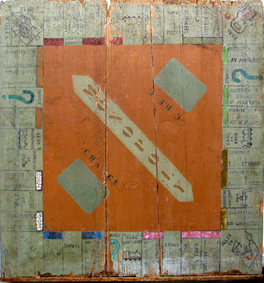 Edition: Monopoly Self
made War (?) edition, made of wood Edition: Monopoly Self
made War (?) edition, made of wood
Maker: J.Ventajou, son of Gabriel Ventajou (?) - ±1944
Dimensions of the board: 51.5 x 52 cm
The game:
This set was offered februari 2007
on the internetsite
ebay
for only € 10,-, while it probably is an edition with a
very
interesting historical background.
In the rusty biscuits tin that goes with the set for its accessories is a nicely
hand-written card from the maker (same
handwriting as of the Chance and Caisse de Communauté cards) with following address:
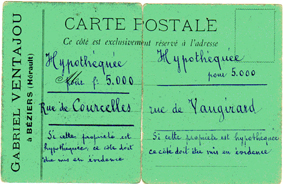 J.Ventajou
J.Ventajou
Murviel les Béziers
Gare Béziers -
Hérault
a little village in the
south of France, where even a "Chemin de Ventajou"
exsist. Maybe he/she, or next of kin, can be found again, so that the true
history of this game can be retrieved!
J. applied old, unused postcards of his father Gabriel for the property cards.
Conclusion: Son had probably continued his fathers stationer's shop.
There he probably had sufficient time to accurately write all property deeds.
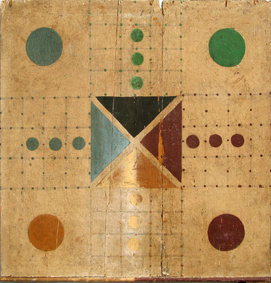 There
are a number of reasons to suppose this game was made around W.W.II, such as: There
are a number of reasons to suppose this game was made around W.W.II, such as:
 | The poor
finish of the game board as well as the property deeds and cards, banknotes,
tokens and houses/hotels.
The board is composed of a few small planks of harsh wood, after which its
surface was filled to get it processed.
Only 2 painting colors were applied: a light blue
green for the properties and red brown
for the board's midfield.
(For the Aggravation game side 5 colors have been applied, viz.: blue
green,
green, brown, black
and beige-yellow.)
(Click on the picture of the board for a larger image, so
that details can be better examined .)
In order to reproduce the color bars of the properties as good as possible
with the materials the maker had at his
disposal, he glued strips of paper on the board and painted them. |
 | The economical
use of the game board. Although it mainly concerns Monopoly, the other
side of the board has been
used for Aggravation. Along 2 sides of the board a rim has been applied in
such a way that this side stay free from the
underground when Monopoly is played. Compare this wooden set with those of Amsterdam
and Rotterdam (only in Dutch).
The applied
rubber handstamp looks familiar to me, because I myself used to play with
such a stamp, just after W.W. II. |
 | The fact the
biscuits tin of "Biscuits Brun" (Nr. 2.710) was still worth
1 franc, as can be read from the bottom of the tin:
"Cette boite sera remboursée 1 Franc si elle
est rendue en bon état".
|
The streets and stations
are those of the official French edition of course, so of the capital Paris.
The design is of course from Waddington, shown by the "backwards
driving" engines at the stations as well as the double names on the
properties. For obscure reasons the maker did use (about) the the same colors
for the color bars of the properties, however, for different groups. Besides he
replaced Bd. Malesherbes by Bd. Magenta and calls Gare Montparnasse "Gare d'Orléans - Montparnasse"
on the property deed only.
It is also striking that the rent for the unbuilt, most expensive yellow
street is not the same (fr.2,200) as those of the other 2 (as it used to be till
about 1980), but here has been made even cheaper (fr.2,000)!
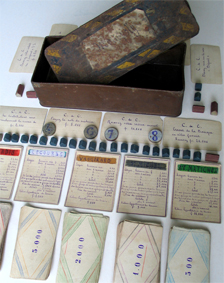 From Départ on the properties are:
From Départ on the properties are:
Boul.
de Belleville - Rue
Lecourbe - Gare Montparnasse - Rue
de Vaugirard - Rue de Courcelles
- Avenue de la République - En
prison/Simple visite - Boul. de la Villette -
Avenue de Neilly - Rue
de Paradis - Gare de Lyon (P.L.M.)
- Avenue Mozart - Boulevard
Saint-Michel - Place Pigalle -
Parc Gratuit - Avenue Matignon - Boulevard
Magenta - Avenue Henri-Martin
- Gare du Nord - Faubourg
Saint-Honoré - Place
de la Bourse - Rue
Lafayette - Allez en prison - Avenue
de Breteuil - Avenue Foch - Boulevard
des Capucines - Gare Saint- Lazare (État)
- Avenue des Champs-Élysées and the Rue
de la Paix.
The dimensions of the property
deeds are 68x 88 mm, those of the Chance
and Caisse
de Communauté cards are 52x88 mm.
The neutral banknotes (54x95 mm) are made of thin paper and hand colored
with color pencils piece by piece. Their denominations are printed with a rubber
handstamp. The 6 denominations are resp. 500 - 1,000 - 2,000 - 5,000 -10,000
and 50,000. (Would those of Fr.100 never have been made?)
As it was usual till
about 1950, the tokens of this game also exsist of flat, round discs
with a diameter of 20 mm. They also are but 4, showing the numbers 4 - 6 - 7
and 8.
Now only 24 small (10x10x10
mm) dark green houses and 6 unequal (abt.10x18x10
mm) dark red hotels are with the set
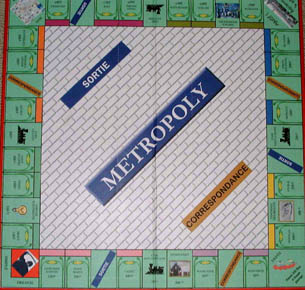 Edition: Métropoly Edition: Métropoly
Makers: Three friends of Jean-François
Dias - Paris - 2000
Dimensions of the box: 51 x 27 cm
of the game board: 48.5 x 48.5 cm
The game:
This very interesting game was given to the Parisian Jean-François by his friends on his
45th anniversary. It concerns the Métro
of Paris existing exactly 100 years.
The game board's midfield situates you in a metro station rightaway,
with it's blue (station) sign, the orange
Correspondance sign and the blue
Sortie sign.
The properties are stations of 8 different
Métro lines. They have the same colors as the lines 1 to 8 on all maps and plans. Of
course Start is called Dépôt (the place where the trains
leave from). From Dépôt on the properties are:
Line 8: Concorde - Madeleine
Gare Montparnasse
Line 7: Cadet - Pont Marie - Chaussée d'Antin
Simple préavis ou grève (Simple préavis ou grève (Simple warning or
strike)
Line 6: Bercy - Passy -Service Electricité - St Jaques
Gare de Lyon
Line 5: Jaurès - Richard Lenoir - Austerlitz
Bon plan
Line 4: Châtelet - Cité - St Michel
Gare du Nord
Line 3: République - Bourse - Service d'Entretien
(Maintenance) - Réamur
Manif, resoignez la grève (Go demonstrate; go on
strike)
Line 2: Blanche - Porte Dauphine - Monceau
Gare St Lazare
Line 1: Etoile - Bastille
All property deeds show a picture of the concerning station. All these very high
quality pictures have been spontaneously made available by the Paris Métro
Organisation RATP.
Very original Chance and Caisse de Communauté have been
substituted by Correspondance and Sortie.
The space Income Tax is here .... Pickpocket. That has been
thought of! The Free Parking field has been substituted by Bon Plan,
meaning as well Good Card as Good Plan. And so the Extra Tax space
is now Contrôle des billets
(Ticket control).
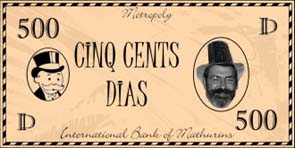 The banknotes are also very original, because
the currency is expressed in Dias a pithy name very useful for this purpose. The
"International Bank" is named after the Rue Mathurins (sailors) in
which street the company is settled where Jean-François
is working. The portraits on the banknotes are of Mr. Monopoly and Mr.
Dias himself. Besides Dias is also the the abbreviation of "Devise
Internationale des Actions Souterraines" (International Subway Auction
Currency). There are 7 banknotes in the denominations of
1 -
5
- 10 ( white) - 20 - 50
- 100 and 500. The banknotes are also very original, because
the currency is expressed in Dias a pithy name very useful for this purpose. The
"International Bank" is named after the Rue Mathurins (sailors) in
which street the company is settled where Jean-François
is working. The portraits on the banknotes are of Mr. Monopoly and Mr.
Dias himself. Besides Dias is also the the abbreviation of "Devise
Internationale des Actions Souterraines" (International Subway Auction
Currency). There are 7 banknotes in the denominations of
1 -
5
- 10 ( white) - 20 - 50
- 100 and 500.
Instead of houses you now buy
yellow "2- eme classe tickets",
right angled chips divided into the zones 1 to 4. The hotels are blue
green
"tickets toutes zônes".
The 6 tokens are made of metal and are elements of the metro:
Blue ticket, present-day 2nd class ticket -
Set of 4 tickets, all the tickets used since the opening - Wagon - M(full),
the old Métro-logo - M(open), the present-day Métro-logo and a full
metal Door, the entry made by Guimard, the first designer of the Métro.
The total is in a "borrowed" box with the well-known red
plastic insert.
The owner is looking for a
publisher for this very special game collectors from all over the world will
certainly be very interested in.
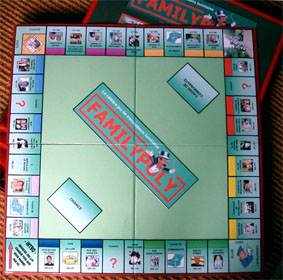 Edition:
Familypoly Edition:
Familypoly
"Le célèbre jeu de transactions familiales
(The famous game of family transactions)
Édition spéciale juin 2005"
Makers: J-F's daughters Laurène and Camille with their grand-uncle Michel - Paris
Dimensions of the box: 51 x 27 cm
of the game board: 48.5 x 48.5 cm
The game:
Jean-François Dias still seems to be an avid collector since his
family could gladden him by making another game for his 50th anniversary.
He proudly tells about this unique gift:
"My daughters Laurène and
Camille wanted to surprise me with a special anniversary present. Together
with their grans-uncle Michel they collected pictures of the family (including
cousins, nephews etc.) and some
close friends of mine, so they could built the game.
The titles of the deeds have been drawn at random by 2 lawyers and a by them
signed certificate was drawn up (because of possible susceptibilities) and
subsequently positioned on the
game board in order of the random draw.
Each property shows a picture of members of a family related to
me, or friends, with the name of the street they live.
The stations are the 4 Beatles, because I love them very much.
The Free Parking corner is a picture of my garden where visitors
usually park their cars. It is free indeed and much safer than the street.

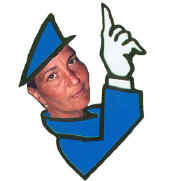 |
My wife
is the policewoman.
She doesn't send me to prison, but to
Carrefour's (a well known supermarket
we use to go) because she knows I hate this.
The small red,
white and blue signs inside,
represents the Carrefour logo.
"En courses..." mean "While shopping..." |
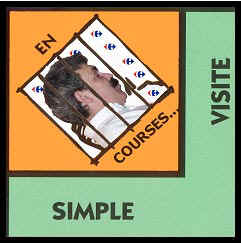 |
The
box is again a "borrowed" box, this time
of the Standard edition ref. 00009 with red
rims and same color plastic insert.
The lid shows the Familypoly bar as well as
a collage of all family pictures used.
The names of the Chance and Caisse de Communauté
cards have remained unchanged except of course for the instructions. Their back
sides show the Familypoly bar.
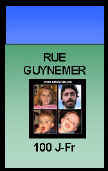 Some
instructions are: Some
instructions are:
 | "Nala has won a beauty contest. Receive 10 J-Fr from the
bank". (Nala is our dog, we love her but she's not particulary
pretty.) |
 | "Buy a gift to Arthur & Vadim. Pay 50 J-Fr to the player
who owns the property Rue Guynemer. If nobody owns this property,
pay this amount to the bank". (Arthur and Vadim are my
twins baby grandchildren. Their dad is my son Emmanuel who made up the picture
of
his family for the game. As you can see, he's also a Beatles fan.)" |
The currency of the banknotes is Jean-Franc this time and not
Jean-Euro, which by the way
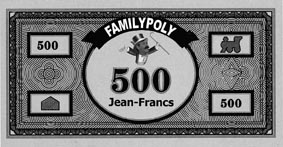 sounds not at all as good as Jean Franc!
(In fact, Jean-Fran is my nickname, very few people call
me by my complete christian name Jean-François). sounds not at all as good as Jean Franc!
(In fact, Jean-Fran is my nickname, very few people call
me by my complete christian name Jean-François).
There are 7 banknotes are printed in black
on colored paper in the denominations of
1 -
5
- 10 - 20 -
50
- 100 and 500.
The 6 tokens, houses and hotels are those from the
standard edition."
|